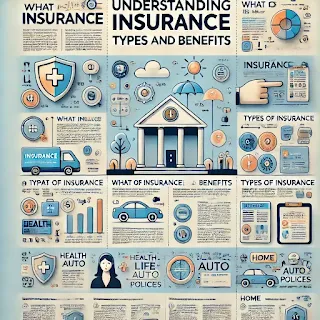Insurance: A Comprehensive Guide
1. Understanding Insurance
Insurance is essentially a contract, known as a policy, between an individual or entity (the insured) and an insurance company (the insurer). The policyholder pays regular premiums to the insurer, who in return promises to provide financial compensation or coverage in the event of a loss or specific incidents covered by the policy. This arrangement helps protect individuals and businesses from unexpected financial burdens.
The key elements of an insurance policy include:
Premium: The amount paid by the policyholder, typically monthly or annually.
Deductible: The initial amount that the insured must pay out-of-pocket before the insurer covers the remaining costs.
Policy limit: The maximum amount the insurer will pay for a covered loss.
Claim: A request made by the insured to receive payment based on the terms of their insurance policy.
2. Types of Insurance
Insurance products are designed to address different types of risks, and each type serves a unique purpose. The main categories include:
Health Insurance: Health insurance provides coverage for medical expenses, ranging from routine checkups to hospitalizations. It is crucial for individuals and families to manage healthcare costs and often includes preventive care, emergency services, and prescriptions.
Life Insurance: This type of insurance provides financial protection to the family or dependents of the insured in case of their death. Life insurance can be term-based (for a specific period) or whole-life (providing lifelong coverage)
Property Insurance: Property insurance, including home and renter’s insurance, protects against damage or theft of property. It covers risks such as fire, natural disasters, theft, and vandalism, ensuring that property owners or tenants can recover financially from these incidents.
Auto Insurance: Mandatory in many countries, auto insurance protects vehicle owners against financial loss in the event of accidents, theft, or damage. It often includes liability coverage, which compensates for damages to other people or their property.
Business Insurance: Businesses face various risks, from property damage to employee injuries and liability claims. Business insurance policies are tailored to protect assets, cover liability, and mitigate risks associated with operations. Examples include general liability, professional liability, and workers’ compensation insurance.
3. Benefits of Insurance
Insurance offers several benefits that extend beyond financial security. These include:
Risk Management: Insurance allows individuals and businesses to share and transfer risk, minimizing financial exposure to unforeseen events.
Economic Stability: By providing a safety net, insurance contributes to economic stability, especially during large-scale events such as natural disasters. Insurers play a role in rebuilding economies by providing funds for reconstruction.
Encourages Savings: Life insurance and similar policies encourage long-term financial planning and saving, benefiting both individuals and the economy.
Promotes Investment: Insurance companies invest collected premiums in a range of financial instruments, contributing to market liquidity and economic growth.
Legal and Social Responsibility: Many forms of insurance, such as health and auto insurance, are legally required, promoting social welfare and reducing the financial burden on public resources.
4. The Role of Insurance in the Economy
Insurance is a pillar of economic development, with wide-reaching effects on multiple sectors. Here’s how it benefits the economy:
Facilitating Business Operations: Insurance helps businesses manage risks, which encourages entrepreneurship and investment. Small and large enterprises can operate with the confidence that they have a safety net against potential losses.
Creating Employment: The insurance industry generates numerous jobs, including those of underwriters, claims adjusters, agents, actuaries, and customer service representatives. These professionals contribute to the economy by providing vital services.
Investment in Capital Markets: Insurers accumulate large reserves through premiums and use these funds to invest in capital markets, which fuels economic growth. These investments support infrastructure projects, technological innovation, and other areas that contribute to the GDP.
Social Protection: By offering coverage for health, life, and property, insurance reduces the financial burden on individuals and the government, contributing to a more resilient society. It also prevents individuals from falling into poverty due to unexpected events, promoting social stability.
5. Challenges Facing the Insurance Industry
Despite its advantages, the insurance industry faces challenges, including:
Fraud and Abuse: Insurance fraud, such as exaggerated claims or false information, increases costs for insurers and, ultimately, policyholders. Fighting fraud is an ongoing challenge requiring sophisticated detection methods and regulatory action.
Changing Risk Landscape: Climate change, cyber risks, and pandemics introduce new risks that insurance companies must adapt to. These evolving challenges require insurers to continuously innovate and adjust their risk assessment models.
Regulation and Compliance: Insurance is highly regulated, which ensures consumer protection but also creates operational complexities. Insurers must adhere to evolving regulations, sometimes increasing operational costs.
Technological Disruption: Digital transformation is reshaping the insurance industry. While technology improves customer experience and efficiency, it also requires significant investment and adaptation.
6. The Future of Insurance
The insurance industry is rapidly evolving to meet changing consumer expectations and risks. Innovations such as telematics in auto insurance, AI-driven underwriting, and blockchain for fraud detection are transforming how insurance is managed. Additionally, the rise of digital insurance platforms is making it easier for consumers to compare and purchase policies online. These trends indicate a future where insurance becomes increasingly personalized, accessible, and integrated with technology.
Conclusion
Insurance is a critical component of modern society, offering essential protections for individuals, businesses, and economies. By managing and distributing risk, insurance enables financial stability, promotes economic development, and encourages investment and innovation. As the industry continues to adapt to new challenges and incorporate technological advancements, insurance will play an even more significant role in ensuring economic resilience and security for future generations.

